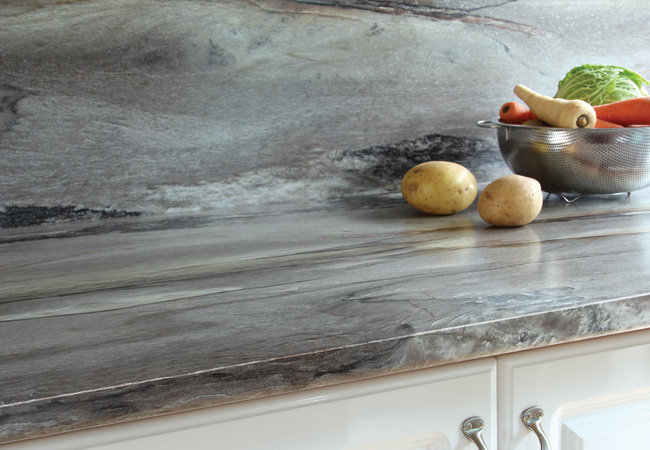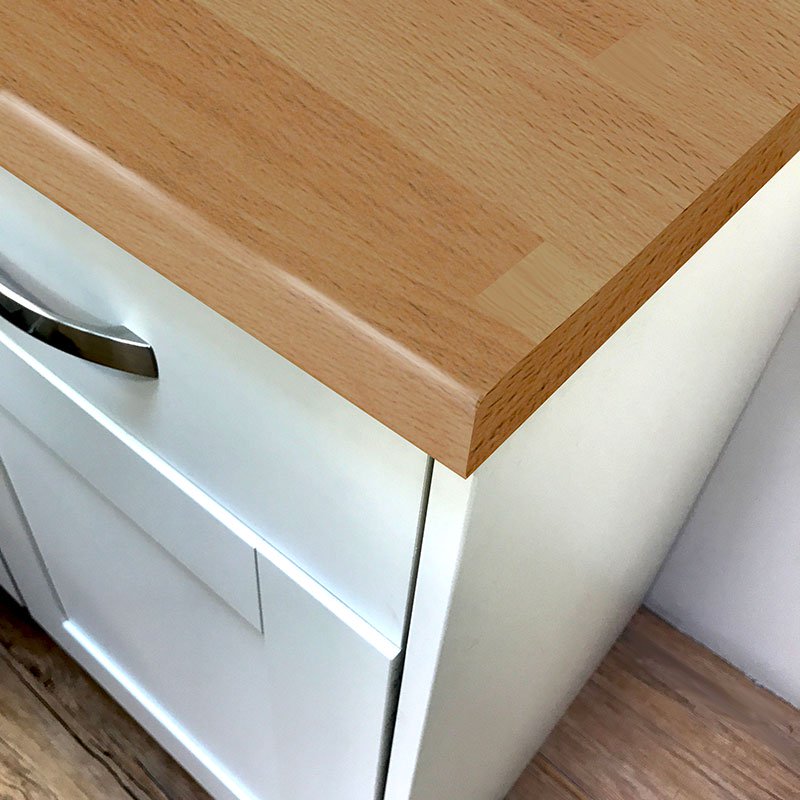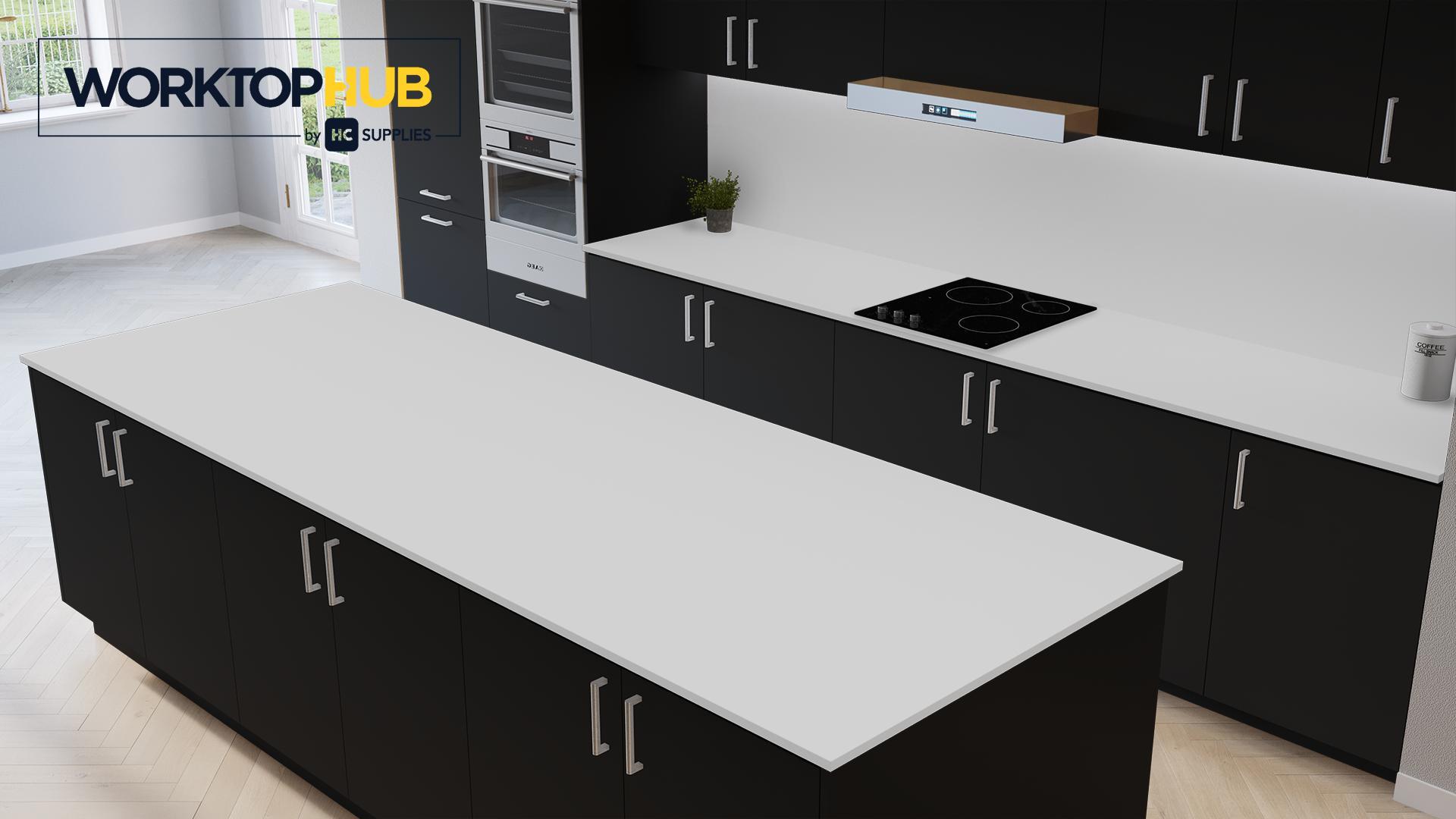Renovating your kitchen and choosing the right elements can be incredibly overwhelming and confusing; gas or induction hob. Slab style doors, or matte finish shaker style? And then there’s the worktop!
If you’re at the design stage of your kitchen project, the chances are you’ve looked at buying a wooden worktop. But, you might still not know whether solid wood countertops are worth buying.
How practical are wooden worktops? Are they durable? Are they easy to maintain and clean? Are they better, or worse than quartz or composite worktops? There are so many questions to answer. That’s why we’ve put together a comprehensive solid wood worktop buying guide, looking at the styles available and the most important things to consider before you commit to choosing wood as your worktop material.
Want to skip ahead? Click any of the links below:
- What’s the Difference Between Solid Wood and Solid Surface Worktops
- Why Choose Solid Wood Worktops
- Are Solid Wood Worktops Practical
- Wooden Worktop Styles
- How To Treat Solid Wood Worktops
- How to Clean Solid Wood Worktops
What’s the Difference Between Solid Wood and Solid Surface Worktops?
If you’re comparing worktop materials, you might have heard of both solid wood and solid surface worktops but do you know what the differences are?
Solid wood work surfaces are made using staves of separate timber, all of the same type, which are finger jointed in length. After this, the work surfaces undergo butt jointing to create the width. In most cases, wooden worktops are then oiled to create a water repellent finish but some wooden worktops can be supplied unfinished.
Solid surface is the term used for any stone such as quartz or granite worktops, or artificial solids such as acrylic. In general, solid surface worktops are used in contemporary kitchen designs, whereas wooden work surfaces can be used in both traditional and contemporary kitchens alike.
Why Choose Solid Wood Worktops?
Solid wood worktops offer a huge range of benefits for any kitchen.
Natural Beauty
If you’re looking for a tactile and high quality finish, a wooden work surface is unmatched. It may not provide the same durability as a corian or quartz countertop, or be as cost effective as a laminate worktop, but a solid wood worktop is unrivalled in adding natural beauty to your kitchen.
We love how wooden worktops age, mature, lighten and darken, providing you with a kitchen feature that evolves as your house does.
Unique & Diverse
With so many different wood grains and types available and no two samples being the same, a wooden worktop can provide a truly unique focal point for your kitchen. The variation in staves and grains will have a major impact on the overall look of your kitchen.
The range of colours available also guarantees that you’ll find something perfect to complement the design of your kitchen.
Water Resistant & Hard Wearing
Many hardwood worktops have naturally occurring oils, making them water resistant and, as they have solid edges, they are ideal for high water areas, such as when using Belfast sinks.
Although they do need treating on a quarterly basis, solid wood worktops are hard wearing, requiring minimal cleaning or maintenance. Small dents and scratches that can occur over time through use, can be covered with danish oil or wax and particularly deep scratches can be sanded out during the treatment stage.
Are Solid Wood Worktops practical?
As with any natural material, solid wood requires some love and care to keep it in perfect condition. Although they may not be as hard wearing as quartz worktops, or as versatile as laminate worktops, they bring an element of class to any kitchen design.
On a daily basis in a family home, solid wood worktops are practical; all you need to do is clean away spills and stains using a damp cloth. Another benefit of solid wood worktops is that they can be sanded down, unlike laminate or granite, meaning a chip or a scratch isn’t the end of the world because you can sand the worktop and remove it.
Wooden Worktop Styles
There are a number of different materials you can choose from when you want a wooden worktop. The best wood for kitchen worktops will depend on your kitchen style, taste and what you’re looking for from your worktop. Each wood has its own style and benefits which it’s important to be aware of to make sure you choose the best type of wood for kitchen worktops.
Oak
Solid oak is the most versatile of all wood worktop finishes, complimenting a modern kitchen, but most at home when coupled with a traditional kitchen style such as a neutral toned shaker style.
The oak grain is extremely hard wearing and will darken and mature over time, making it ideal for an evolving family home.
Learn more about oak worktops in our buying guide.
Walnut
Walnut worktops are both robust and delicate, marrying rich colour variation with a slightly curved grain to provide a naturally decorative finish. Choose walnut worktops for an ever-popular, stylish addition to your kitchen.
Walnut worktops are the ideal choice for creating a contrast with lighter cupboards, providing an ultra modern and contemporary look.
The deep browns and curved grain can add interest to an otherwise subdued design, making walnut worktops a feature in their own right.
Take a look at our walnut worktops buying guide for more information.
Beech
Beech worktops are possibly the most popular of all wood grains thanks to their robust and versatile appearance. On the whole, they provide a range of rich tones from bright oranges to deep reds.
Variations in staves and wood grains give beech work surfaces a charm and diverse finish that is unmatched and as the worktop ages, it will only get better.
Want to know more about beech worktops? Check out our beech worktops buying guide.
Cherry
Cherry worktops bring warmth to any kitchen with their deep, warm red tones. The butchers block cherry worktop has become a popular choice over recent years as it is one of the more versatile wood grains available; fitting in any kitchen style and maturing over time to add interest.
Couple cherry worktops with cherry door knobs to achieve that perfect country kitchen look.
Maple
The lighter, subdued tones of maple worktops make them ideal in farmhouse kitchens and compliment more traditional designs. We recommend coupling maple tops with matching door knobs and flooring, with contrasting door finishes for a striking but coordinated look.
Wenge
If you’re looking for something a little darker than walnut with an exotic twist, wenge worktops are the perfect choice. A light grain and very dark brown pattern makes wenge particularly striking when contrasted with lighter cupboards such as a gloss white slab or oyster.
What’s more, wenge is known to have a density 50% higher than oak, making it incredibly strong and resistant to dents and scratches.
Teak
A tropical hardwood, teak worktops are incredibly dense and hard wearing, but also incredibly characterful and rich. The grain on teak worktops tends to be a little more apparent than on more reserved surfaces such as oak or cherry, making it an ideal choice for adding interest to a pared back kitchen design.
Due to the natural oil fibres in teak timber, it is fairly resistant to water without treatment (although we do advise treatment to make doubly sure), giving it an advantage when used with Belfast sinks for example.
Sapele
With a distinctive cherry colour and characterful striped grain, there’s no mistaking a sapele worktop. The colour lends itself well to a multitude of kitchen styles, contrasting well with darker cabinets, but also complimenting a softer cream or light grey design.
Solid Wood Worktop maintenance
We recommend treating your wooden worktops every three months, to ensure they stay hard wearing and well protected.
Danish oil is perfect for treating your work surfaces, as it dries quickly, is water resistant and provides a safe finish for preparing food. Avoid using food based oil such as cooking oil (you would be surprised how common this is) as they effectively cause bacteria build up long term.
Lacquering provides a glossier finish than danish oil, which can give wooden worktops a more modern look. Beware of using a lacquer that is too ‘glossy’ as this will remove the natural appearance of the surface.
Wax has become a popular alternative to oil in recent years as there are a number of finishes available and generally, it can be easier to apply.
How to Clean Solid Wood Worktops
Daily cleaning can be done using warm water and washing up liquid. If you want to make sure you have removed bacteria and do a ‘deeper clean’ of your surfaces, mix washing up liquid with white vinegar and water into a spray bottle for a soft antibacterial solution. We also recommend avoiding harsh chemical cleaners, although some antibacterial cleaners are fine to use.
Don’t be tempted to leave spillages, clean them up immediately as natural materials such as wood are more prone to staining than laminated or acrylic tops.
Avoid using an overly wet cloth, always ring out cloths before use.
Make sure you only use soft cloths as more coarse scouring pads for example can scratch the surface.
Hopefully, you’re a little clearer on whether or not solid wood worktops are the right choice for you. If they are, why not have a look at our extensive range of solid wood worktops, including walnut, beech, maple and many other styles and finishes. Have wooden worktops in your kitchen already?
Take a look at our full range of solid wood worktops and find the perfect worktop for your kitchen today.





